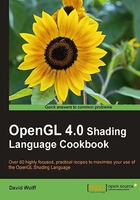
Determining the GLSL and OpenGL version
In order to support a wide range of systems, it is essential to be able to query for the supported OpenGL and GLSL version of the current driver. It is quite simple to do so, and there are two main functions involved: glGetString and glGetIntegerv .
How to do it...
The code shown below will print the version information to stdout:
const GLubyte *renderer = glGetString( GL_RENDERER );
const GLubyte *vendor = glGetString( GL_VENDOR );
const GLubyte *version = glGetString( GL_VERSION );
const GLubyte *glslVersion =
glGetString( GL_SHADING_LANGUAGE_VERSION );
GLint major, minor;
glGetIntegerv(GL_MAJOR_VERSION, &major);
glGetIntegerv(GL_MINOR_VERSION, &minor);
printf("GL Vendor : %s\n", vendor);
printf("GL Renderer : %s\n", renderer);
printf("GL Version (string) : %s\n", version);
printf("GL Version (integer) : %d.%d\n", major, minor);
printf("GLSL Version : %s\n", glslVersion);
How it works...
Note that there are two different ways to retrieve the OpenGL version: using glGetString and glGetIntegerv. The former can be useful for providing readable output, but may not be as convenient for programmatically checking the version because of the need to parse the string. The string provided by glGetString(GL_VERSION)should always begin with the major and minor versions separated by a dot; however, the minor version could be followed with a vendor-specific build number. Additionally, the rest of the string can contain additional vendor-specific information and may also include information about the selected profile (see the Introduction to this chapter).
The queries for GL_VENDOR and GL_RENDERER provide additional information about the OpenGL driver. The call glGetString(GL_VENDOR) returns the company responsible for the OpenGL implementation. The call to glGetString(GL_RENDERER) provides the name of the renderer which is specific to a particular hardware platform (such as "ATI Radeon HD 5600 Series"). Note that both of these do not vary from release to release, so can be used to determine the current platform.
Of more importance to us in the context of this book is the call to glGetString(GL_SHADING_LANGUAGE_VERSION)which provides the supported GLSL version number. This string should begin with the major and minor version numbers separated by a period, but similar to the GL_VERSION query, may include other vendor-specific information.
There's more...
It is often useful to query for the supported extensions of the current OpenGL implementation. In versions prior to OpenGL 3.0, one could retrieve a full, space separated list of extension names with the following code:
GLubyte *extensions = glGetString(GL_EXTENSIONS);
The string that is returned can be extremely long and parsing it can be susceptible to error if not done carefully.
In OpenGL 3.0, a new technique was introduced, and the above functionality was deprecated (and finally removed in 3.1). Extension names are now indexed and can be individually queried by index. We use the glGetStringi variant for this. For example, to get the name of the extension stored at index i, we use: glGetString(GL_EXTENSIONS, i). To print a list of all extensions, we could use the following code:
See also
The GLEW library has additional support for querying extension information. See Using the GLEW library to access the latest OpenGL functionality.